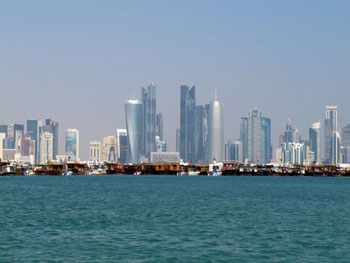
by Irene Butler
Since tales of Aladdin swept my imagination away on a magic carpet in grade school, my desire to journey through the Arabian Peninsula has not waned. Sixty years later I am to realize this dream. My husband Rick and I arrive in Qatar, the small country that jets into the Arabian Sea like a thumb off Saudi Arabia’s border, to discover how this culture steeped in tradition has melded with modernity.
On our first day in the capital of Doha we jauntily begin a stroll on Al-Corniche, the eight kilometer, U-shaped avenue that hugs the shimmering turquoise Gulf waters and is dotted with date palms, flowering plants and amazing sculptures. After a few kilometres we know why we are almost alone on this promenade and the stream of vehicles on the roadway with windows rolled-up-tight against the broiling sun makes sense. Our walk is likened to a hike across the Sahara. We thirstily forge ahead to the gleaming towers of glass and steel around the bend, knowing they are not a mirage. Qatar has not escaped skyscraper building fury of the oil-rich countries. We welcome the stunning marble and glass architecture of the City Centre Doha Mall, and blissfully nestle in coffee shop armchairs with a litre of H2O and silky-smooth cappuccinos before heading back to our hotel…in an air-conditioned taxi.
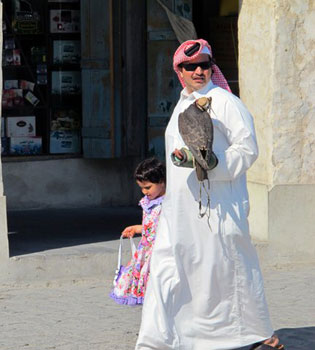 We find Souq Waqif (market) the perfect place to soak up tradition, with a bonus of both outdoor sections and those sheltered from Old Sol. Waqif has been around since the days when Bedouin nomads traded goats, sheep and wool for essential items. Restorations have not changed the maze of passageways with mud rendered walls and wood beamed ceilings. We meander past small shops piled high with spices, dates, figs, perfumes, pots, dishes, plastic everything, aquarium fishes, birds, puppies, and bunnies. A father passes with his small daughter clinging to his one hand, while in the other he carries his purchase – a falcon. The ancient art of Falconry dates back to at least the 7th century BC, and although Westerners find using these birds of prey for sport objectionable, it is prevalent in the Arab countries and the Bedu are the grand masters.
We find Souq Waqif (market) the perfect place to soak up tradition, with a bonus of both outdoor sections and those sheltered from Old Sol. Waqif has been around since the days when Bedouin nomads traded goats, sheep and wool for essential items. Restorations have not changed the maze of passageways with mud rendered walls and wood beamed ceilings. We meander past small shops piled high with spices, dates, figs, perfumes, pots, dishes, plastic everything, aquarium fishes, birds, puppies, and bunnies. A father passes with his small daughter clinging to his one hand, while in the other he carries his purchase – a falcon. The ancient art of Falconry dates back to at least the 7th century BC, and although Westerners find using these birds of prey for sport objectionable, it is prevalent in the Arab countries and the Bedu are the grand masters.
This market is frequented by those hooked on hookahs. Every restaurant and cafe is filled with customers puffing their choice of sheesha (flavoured tobacco) through bubbling water pipes. The air is opaque with the smoky bouquet of sweet apple, strawberry, rose and mint. Seeing Rick puzzle over a hookah apparatus, Hussein, a waiter at Café Tasse, invites us out back to where a dozen pipes are being made ready for patrons.
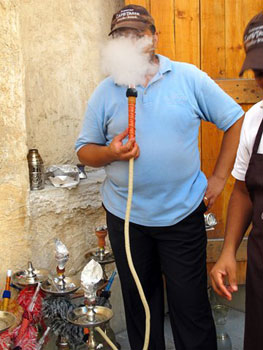 In a Sheesha 101 lesson Hussein demonstrates the basics. Billows of smoke rise into the air with each puff. Rick tries next. With my camera aimed, I wait…and wait for a billow…ahhh, at last, a pouf of smoke the size of a walnut. “Not as easy as it looks,” claims Rick, as Hussein cheers, “Way to go!”
In a Sheesha 101 lesson Hussein demonstrates the basics. Billows of smoke rise into the air with each puff. Rick tries next. With my camera aimed, I wait…and wait for a billow…ahhh, at last, a pouf of smoke the size of a walnut. “Not as easy as it looks,” claims Rick, as Hussein cheers, “Way to go!”
Upon checking our “must do” list for Qatar, seeing the desert landscapes and camel races are in the forefront. The dilemma – not even the tour offices have advance notice of when the camel races will be held. We are told to check the daily newspapers for race dates, or call the racing committee.
It is our new friend Jerri to the rescue! Jerri is one of the many expatriates who works in the country’s oil industry. He graciously offers to drive us to the unique limestone formations known as “desert mushrooms” at Bir Zekreet, and lucky for us, the famed camel race track of Al-Shahaniya is on the way!
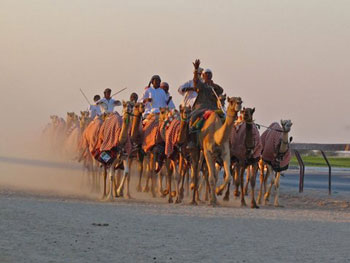 As we approach the track, my heart leaps at the sight of these ships of the desert everywhere; in compounds along the roadway, and strings of them crisscrossing the highway bringing traffic to a halt. We pull into the Al-Shahaniya complex and gleefully make our way to the track. Practicing jockeys and camels in bunches race by stirring up clouds of dust. Some of the jockeys bouncing along on an adult camel also hold the reins of a juvenile camel with no rider; no doubt a learning process for the gangly young’un.
As we approach the track, my heart leaps at the sight of these ships of the desert everywhere; in compounds along the roadway, and strings of them crisscrossing the highway bringing traffic to a halt. We pull into the Al-Shahaniya complex and gleefully make our way to the track. Practicing jockeys and camels in bunches race by stirring up clouds of dust. Some of the jockeys bouncing along on an adult camel also hold the reins of a juvenile camel with no rider; no doubt a learning process for the gangly young’un.
Duly thrilled by this “sport of sheikhs”, we barrel south again and make it to Bir Zekreet at sunset. The fading light casts an eerie glow over the weirdly spectacular “mushrooms”, the result of winds that have whittled away the softer sedimentary rock leaving pillars below large intact tops – a geography lesson of desert formation.
We proceed still further south to the town of Dukhan, the location of a massive natural gas plant and huge compound for employees with every amenity – deluxe accommodations, shopping and restaurants. Qatar is the largest exporter of liquefied natural gas in the world. Along with crude oil and banking, the country has one of the fastest growing world economies, with an extremely high per capita income. The State of Qatar is ruled by the popular emir, Sheikh Hamad bin Khalifa al-Thani, whose family has been in power since the mid-18th century. In 2005 a cabinet and advisory council was voted in to assist in the running of Qatar, which is considered one of the most politically stable countries in the region.
 Back in Doha we see more evidence of the country’s wealth in the stadiums of Sport City, built for the 2006 Asian Games, the largest ever held. At the nearby Villagio Mall Jerri says, “the extravagance must be seen to be believed”. Shoppers take time for a gondola ride along the faux-Venetian canal running through the middle of the mall’s ultra-wide corridors. A gigantic food court overlooks an ice rink where a hockey game is in progress; the skating finesse and puck-handling of the players aged 12 to 14 years is top-notch.
Back in Doha we see more evidence of the country’s wealth in the stadiums of Sport City, built for the 2006 Asian Games, the largest ever held. At the nearby Villagio Mall Jerri says, “the extravagance must be seen to be believed”. Shoppers take time for a gondola ride along the faux-Venetian canal running through the middle of the mall’s ultra-wide corridors. A gigantic food court overlooks an ice rink where a hockey game is in progress; the skating finesse and puck-handling of the players aged 12 to 14 years is top-notch.
 Being Friday, the first day of the Muslim weekend, the mall is wall-to-wall with congregations of family and friends. In the multi-cultural mix of a population of 900,000, 75% are expatriates from around the world employed in jobs ranging from janitors to CEOs. Qataris make up the remaining 25% and are distinguishable by their dress and apparent affluence. Rolex watches peek from the sleeves of men’s impeccable white throbe (floor-length shirt-dress) as they twirl a set of prayer beads between thumb and forefinger, which may be made of pearls, jade, or gold nuggets. Their gutra (white head cloth) secured by black-tasselled head-rope called an agal looks dashing. Women’s abeyyas (black robes) and hejabs (head scarves) are trimmed with gold, silver or gems; their fingers and wrists flash diamonds the size of marbles as they tote bags with purchases from top-fashion designers. Seeing a Lamborghini with gold wheel rims as we left the mall is the ultimate in excess.
Being Friday, the first day of the Muslim weekend, the mall is wall-to-wall with congregations of family and friends. In the multi-cultural mix of a population of 900,000, 75% are expatriates from around the world employed in jobs ranging from janitors to CEOs. Qataris make up the remaining 25% and are distinguishable by their dress and apparent affluence. Rolex watches peek from the sleeves of men’s impeccable white throbe (floor-length shirt-dress) as they twirl a set of prayer beads between thumb and forefinger, which may be made of pearls, jade, or gold nuggets. Their gutra (white head cloth) secured by black-tasselled head-rope called an agal looks dashing. Women’s abeyyas (black robes) and hejabs (head scarves) are trimmed with gold, silver or gems; their fingers and wrists flash diamonds the size of marbles as they tote bags with purchases from top-fashion designers. Seeing a Lamborghini with gold wheel rims as we left the mall is the ultimate in excess.
Our exhilarating week in Qatar went by in a flash. I came away feeling a genie had granted my wish. The bazaar-like souqs and harsh desert terrain were everything I imagined in the Arabia of old, combined with the boom decade’s dazzling skyscrapers and Disney-like malls, all warmly fused with traditional Bedouin hospitality are now fond memories.

Full-day Private Qatar Desert Safari from Doha
If You Go:
Qatar – www.qatartourism.gov.qa
Visas –
Canadians can obtain a visa upon entry.
For requirements see: www.canadainternational.gc.ca/qatar/
Climate –
Summer (May to September) average day temp 35C (95F) but can surpass 50C (122F) high humidity and frequent dust storms.
Winter – pleasant temp during the day 26C (80F) with cooler evenings. Most of the 8cm (3in) of annual rainfall occurs during Dec and Jan.
Religion –
Most Qataris, like Saudi Arabians, adhere to the austere Wahhabi sect of Islam, with strict codes of conduct. Visiting women are not required to don traditional dress (as in Saudi Arabia) but men and women visitors should dress conservatively.
Air Travel to Qatar –
Best since it is difficult to get a transit visa to cross Saudi Arabia from other Arabian Peninsula countries.
www.qatarairways.com
ca.skyscanner.com
Budget hotel suggestion –
Fuda Hotel, Al Muthaf Street, Old Salata, Doha – 5 min walk to the waterfront (no direct website, but look for it on wholesale hotel sites).
About the author:
Travel writer and author, Irene Butler, along with her photographer husband Rick travel the world for 6 months of each year, and have immersed themselves in 85 countries to date. Their home base is Richmond, BC.
All photos are by Rick Butler.


 Jesus’ triumphal entry into Jerusalem on a colt fulfilled the prophecy of Zechariah (Zechariah 9:9). As he descended the Mount of Olives, he stopped and looked out over the city. Jesus wept upon seeing the Holy Temple across the Kidron Valley (Luke 19:41-44) because he knew that Jerusalem would be destroyed – and it came to pass in 70 CE. This event is commemorated half way down the Mount of Olives where you find the “tear drop”-shaped Church of the Dominus Flevit (Latin for “the Lord Wept”).
Jesus’ triumphal entry into Jerusalem on a colt fulfilled the prophecy of Zechariah (Zechariah 9:9). As he descended the Mount of Olives, he stopped and looked out over the city. Jesus wept upon seeing the Holy Temple across the Kidron Valley (Luke 19:41-44) because he knew that Jerusalem would be destroyed – and it came to pass in 70 CE. This event is commemorated half way down the Mount of Olives where you find the “tear drop”-shaped Church of the Dominus Flevit (Latin for “the Lord Wept”).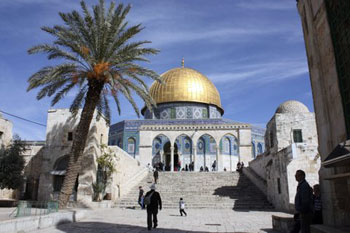 Entering the church, your eyes are immediately drawn to the arch-shaped picture window behind the altar. Those attending mass might be forgiven (hopefully) for being distracted by the magnificent view of the Old City of Jerusalem set within the window frame. The Dome of the Rock and the Church of the Holy Sepulchre are both conspicuous in this picture.
Entering the church, your eyes are immediately drawn to the arch-shaped picture window behind the altar. Those attending mass might be forgiven (hopefully) for being distracted by the magnificent view of the Old City of Jerusalem set within the window frame. The Dome of the Rock and the Church of the Holy Sepulchre are both conspicuous in this picture. Before he was betrayed, Jesus visited the Garden of Gethsemane to pray (Matthew 26:30, Mark 14:32, Luke 22:12, John 13:1). Located at the foot of the Mount of Olives, the Garden of Gethsemane showcases the Basilica of the Agony with its mosaic façade depicting Jesus as the mediator between God and man.
Before he was betrayed, Jesus visited the Garden of Gethsemane to pray (Matthew 26:30, Mark 14:32, Luke 22:12, John 13:1). Located at the foot of the Mount of Olives, the Garden of Gethsemane showcases the Basilica of the Agony with its mosaic façade depicting Jesus as the mediator between God and man.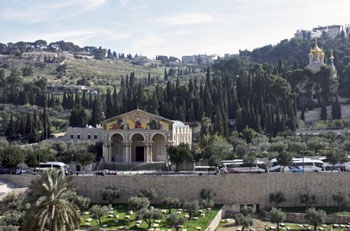 Inside the basilica, dark alabaster windows set the sombre mood for the agony and betrayal of Jesus. The flat “Stone of Agony” near the altar marks the spot where Jesus sweated blood (Luke 22:44) as he prayed. A mosaic behind the altar preserves that moment in time.
Inside the basilica, dark alabaster windows set the sombre mood for the agony and betrayal of Jesus. The flat “Stone of Agony” near the altar marks the spot where Jesus sweated blood (Luke 22:44) as he prayed. A mosaic behind the altar preserves that moment in time. Also on the site of the original Antonia Fortress, the Franciscan Monastery is located opposite the Al-Omariya School on the Via Dolorosa. This monastery houses both the Church of the Flagellation and Church of the Condemnation (the 2nd Station of the Cross).
Also on the site of the original Antonia Fortress, the Franciscan Monastery is located opposite the Al-Omariya School on the Via Dolorosa. This monastery houses both the Church of the Flagellation and Church of the Condemnation (the 2nd Station of the Cross). The Church of the Holy Sepulchre, the holiest site in Christendom, is the traditional site of the crucifixion and tomb of Jesus. Enter the church and climb the well-worn stairs immediately to your right to the top of Golgotha/Calvary (Matthew 23:35, Mark 15:22, Luke 23:33, John 19:17). Here you enter the Roman Catholic Chapel of the Nailing of the Cross – the 11th Station of the Cross.
The Church of the Holy Sepulchre, the holiest site in Christendom, is the traditional site of the crucifixion and tomb of Jesus. Enter the church and climb the well-worn stairs immediately to your right to the top of Golgotha/Calvary (Matthew 23:35, Mark 15:22, Luke 23:33, John 19:17). Here you enter the Roman Catholic Chapel of the Nailing of the Cross – the 11th Station of the Cross. Join the line to enter the Chapel of the Holy Sepulchre inside the Edicule – the 14th Station of the Cross. Inside you find a reconstructed slab on your right consisting of two marble stones. A vase with candles marks the spot where Jesus’ head once rested.
Join the line to enter the Chapel of the Holy Sepulchre inside the Edicule – the 14th Station of the Cross. Inside you find a reconstructed slab on your right consisting of two marble stones. A vase with candles marks the spot where Jesus’ head once rested.
 Set on a sheer hillside, the Church of St. Peter in Gallicantu is the traditional the site of the High Priest Caiaphas’ house. Jesus was brought before Caiaphas immediately after his arrest (Luke 22:54, Mark 14:54, John 18:24, Matthew 26:57). You can easily find this church by looking for the roof with a golden rooster set on top of a cross. The rooster identifies this as the site where Peter denied Christ three times before the cock crowed (Matthew 26:69-75, Mark 14:66-72, Luke 22:55-62, John 18:25-27) hence the name “Gallicantu” (Latin for “the cock’s crow”). A statue in the courtyard depicts the event.
Set on a sheer hillside, the Church of St. Peter in Gallicantu is the traditional the site of the High Priest Caiaphas’ house. Jesus was brought before Caiaphas immediately after his arrest (Luke 22:54, Mark 14:54, John 18:24, Matthew 26:57). You can easily find this church by looking for the roof with a golden rooster set on top of a cross. The rooster identifies this as the site where Peter denied Christ three times before the cock crowed (Matthew 26:69-75, Mark 14:66-72, Luke 22:55-62, John 18:25-27) hence the name “Gallicantu” (Latin for “the cock’s crow”). A statue in the courtyard depicts the event. The churchyard features a number of ruins including olive presses, a bath house and a stone stairway leading to the Pool of Silwan below. Jesus may have used this stairway as he walked from the Coenaculum to the Garden of Gethsemane by way of the Kidron Valley before his betrayal. Visitors also find a model of the Old City of Jerusalem during the 4th-6th centuries CE. The Temple Mount is conspicuously bare and remained that way until the Dome of the Rock was constructed in 691 CE after the Muslim conquest.
The churchyard features a number of ruins including olive presses, a bath house and a stone stairway leading to the Pool of Silwan below. Jesus may have used this stairway as he walked from the Coenaculum to the Garden of Gethsemane by way of the Kidron Valley before his betrayal. Visitors also find a model of the Old City of Jerusalem during the 4th-6th centuries CE. The Temple Mount is conspicuously bare and remained that way until the Dome of the Rock was constructed in 691 CE after the Muslim conquest.
 St. Helena, the mother of the Roman Emperor Constantine, commissioned this basilica in the 4th century CE. Over a century later in 565 CE, the Byzantine Emperor Justinian rebuilt this structure after a Samaritan uprising destroyed it. Add some images from the Crusader Period and you find a hodgepodge of the ages. Even with the past renovations and upgrades, the Basilica of the Nativity remains the oldest continuously operating church in the Holy Land. Your tour begins outside the front door.
St. Helena, the mother of the Roman Emperor Constantine, commissioned this basilica in the 4th century CE. Over a century later in 565 CE, the Byzantine Emperor Justinian rebuilt this structure after a Samaritan uprising destroyed it. Add some images from the Crusader Period and you find a hodgepodge of the ages. Even with the past renovations and upgrades, the Basilica of the Nativity remains the oldest continuously operating church in the Holy Land. Your tour begins outside the front door.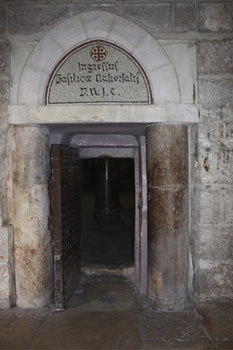 As I strained to enter the basilica through the main door, I suddenly remembered the parable of the camel and the eye of a needle (Matthew 19:24). Known as the “Door of Humility”, the main entrance measures a mere 0.2 by 0.4 square meters. Why would the second holiest site in Christendom require such a small door? Cynics might think that it was to prevent the congregation from exiting en mass during a boring sermon; but actually this centuries-old door was designed to prevent looters from loading up wagons with ill-gotten gains.
As I strained to enter the basilica through the main door, I suddenly remembered the parable of the camel and the eye of a needle (Matthew 19:24). Known as the “Door of Humility”, the main entrance measures a mere 0.2 by 0.4 square meters. Why would the second holiest site in Christendom require such a small door? Cynics might think that it was to prevent the congregation from exiting en mass during a boring sermon; but actually this centuries-old door was designed to prevent looters from loading up wagons with ill-gotten gains. The Grotto of the Nativity has been hewn into the bedrock. I was somewhat taken aback upon entering this cave because the Gospel of Matthew indicates that the three wise men came into a house (Matthew 2:11) not a cave. Apparently the new parents lived as troglodytes during their stay in Bethlehem.
The Grotto of the Nativity has been hewn into the bedrock. I was somewhat taken aback upon entering this cave because the Gospel of Matthew indicates that the three wise men came into a house (Matthew 2:11) not a cave. Apparently the new parents lived as troglodytes during their stay in Bethlehem.
 A narrow hallway leads you from the grotto to two other notable chapels related to the Nativity story. The Chapel of the Innocents commemorates the children slain by King Herod’s soldiers who were trying to locate the infant Jesus (Matthew 2:16-18); and the nearby Chapel of St Joseph is dedicated to the angel appearing to Joseph in a dream and directing him to flee to Egypt with his family (Matthew 2:13).
A narrow hallway leads you from the grotto to two other notable chapels related to the Nativity story. The Chapel of the Innocents commemorates the children slain by King Herod’s soldiers who were trying to locate the infant Jesus (Matthew 2:16-18); and the nearby Chapel of St Joseph is dedicated to the angel appearing to Joseph in a dream and directing him to flee to Egypt with his family (Matthew 2:13). Built in 1861, the Roman Catholic Church of St. Catherine adjoins the basilica. This church commemorates Christ’s appearance to St Catherine of Alexandria. Jesus warned Catherine of her impending martyrdom in 310 CE. At the front of the church, the high altar is situated over the Chapel of the Innocents.
Built in 1861, the Roman Catholic Church of St. Catherine adjoins the basilica. This church commemorates Christ’s appearance to St Catherine of Alexandria. Jesus warned Catherine of her impending martyrdom in 310 CE. At the front of the church, the high altar is situated over the Chapel of the Innocents.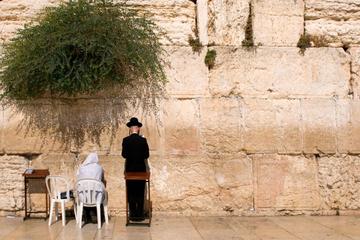
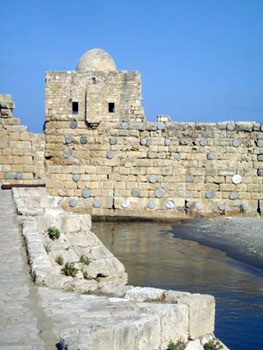
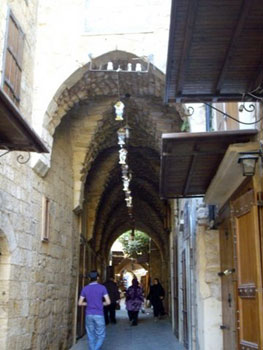 Saida, or Sidon is of course very, very old, about 4000 years to be precise. One of the most important Phoenician city states Sidon has a long history of art, craft and trade. The skills of her craftsmen were even praised by Homer. Therefore it doesn’t come as a surprise that countless workshops are still productive to this day and they are all housed within the walls of the medieval old town.
Saida, or Sidon is of course very, very old, about 4000 years to be precise. One of the most important Phoenician city states Sidon has a long history of art, craft and trade. The skills of her craftsmen were even praised by Homer. Therefore it doesn’t come as a surprise that countless workshops are still productive to this day and they are all housed within the walls of the medieval old town.
 The word saaabuuun again worked its magic and I was finally directed to the olive soap museum which I had particularly come to visit.
The word saaabuuun again worked its magic and I was finally directed to the olive soap museum which I had particularly come to visit. But the medina has even more to offer. Mosques, churches and palaces are wedged into the narrow alleys and sometimes only recognized by looking very closely. As is the case of the Palais Debbane, an Ottoman palace which reveals its treasures only once you have climbed a steep stone staircase and entered through a narrow door.
But the medina has even more to offer. Mosques, churches and palaces are wedged into the narrow alleys and sometimes only recognized by looking very closely. As is the case of the Palais Debbane, an Ottoman palace which reveals its treasures only once you have climbed a steep stone staircase and entered through a narrow door.
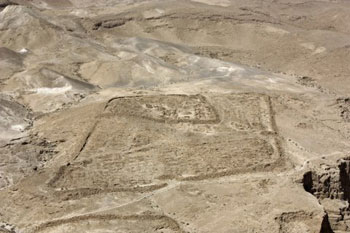 Straddling the shore of the Dead Sea, Highway 90 takes you through some of the most breathtaking desert scenery in the Middle East. You could be forgiven if you simply traveled southward and made an occasional stop to photograph the sandy brown cliffs and wadis (valleys) seemingly flowing into the salty water at the lowest place on earth. However en route, you also pass the unobtrusive sites of Qumran and Masada whose presence are only betrayed by signs denoting the park entrances. Neither site is visible from the road so if you are preoccupied with the scenery, you might miss them. And that would be a shame.
Straddling the shore of the Dead Sea, Highway 90 takes you through some of the most breathtaking desert scenery in the Middle East. You could be forgiven if you simply traveled southward and made an occasional stop to photograph the sandy brown cliffs and wadis (valleys) seemingly flowing into the salty water at the lowest place on earth. However en route, you also pass the unobtrusive sites of Qumran and Masada whose presence are only betrayed by signs denoting the park entrances. Neither site is visible from the road so if you are preoccupied with the scenery, you might miss them. And that would be a shame.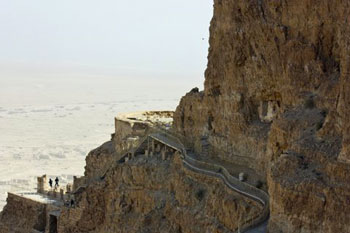 Masada has come to symbolize the tenacity of the modern state of Israel. Each year members of the Israel Defence Forces visit the ancient fortress and swear that “Masada shall not fall again”. But in 73 CE, Masada did fall after a prolonged siege. When the end came, 960 Jewish zealots chose death before slavery and committed mass suicide just hours before the Romans stormed the site.
Masada has come to symbolize the tenacity of the modern state of Israel. Each year members of the Israel Defence Forces visit the ancient fortress and swear that “Masada shall not fall again”. But in 73 CE, Masada did fall after a prolonged siege. When the end came, 960 Jewish zealots chose death before slavery and committed mass suicide just hours before the Romans stormed the site.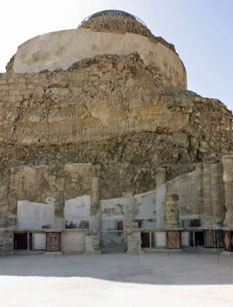 Return to the top of the stairs and walk along the western casemate wall to the appropriately named Western Palace – the largest structure on the plateau. Built around a central courtyard, this palace houses the throne room. The floor features the remnants of a mosaic with floral and geometric patterns.
Return to the top of the stairs and walk along the western casemate wall to the appropriately named Western Palace – the largest structure on the plateau. Built around a central courtyard, this palace houses the throne room. The floor features the remnants of a mosaic with floral and geometric patterns.
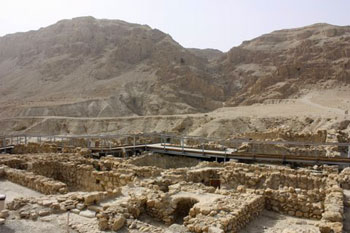 In 1947, a young Bedouin shepherd changed history when he threw a stone into a cave. Upon hearing the sound of shattered pottery, he climbed into the cave to investigate. Inside he discovered a number of earthenware jars containing 2000-year old parchment manuscripts. These documents, now known as the Dead Sea Scrolls, are some of the oldest Bible writings discovered to date. Eventually additional documents were also found in ten other caves, all of which are located near an isolated plateau holding the ancient village of Qumran.
In 1947, a young Bedouin shepherd changed history when he threw a stone into a cave. Upon hearing the sound of shattered pottery, he climbed into the cave to investigate. Inside he discovered a number of earthenware jars containing 2000-year old parchment manuscripts. These documents, now known as the Dead Sea Scrolls, are some of the oldest Bible writings discovered to date. Eventually additional documents were also found in ten other caves, all of which are located near an isolated plateau holding the ancient village of Qumran. Constructed of rough, brown stones and mud/clay mortar, all buildings at Qumran reflect the ascetic and communal lifestyle of the 200 Essenes living there. Believing that they were living in “the end of days”, their lives were focused on strict adherence to religious laws that included ritual bathing, voluntary poverty and an abstinence from worldly pleasures including marriage. Every day residents bathed before prayer and the noon meal. Dressed in white veiled clothing, each person descended steps and submerged himself into the cold water of a ritual bath (miqva’ot). Scattered around the village, ten ritual baths testify to the Essenes’ preoccupation with purity and ritual bathing. Ritual purity was so important that most of the baths had a division along the plaster-covered steps to prevent contact between those ascending (the purified) and those descending (the impure).
Constructed of rough, brown stones and mud/clay mortar, all buildings at Qumran reflect the ascetic and communal lifestyle of the 200 Essenes living there. Believing that they were living in “the end of days”, their lives were focused on strict adherence to religious laws that included ritual bathing, voluntary poverty and an abstinence from worldly pleasures including marriage. Every day residents bathed before prayer and the noon meal. Dressed in white veiled clothing, each person descended steps and submerged himself into the cold water of a ritual bath (miqva’ot). Scattered around the village, ten ritual baths testify to the Essenes’ preoccupation with purity and ritual bathing. Ritual purity was so important that most of the baths had a division along the plaster-covered steps to prevent contact between those ascending (the purified) and those descending (the impure).

